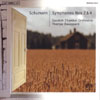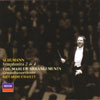Schumann Symphonies Nos 2 & 4
The Swedes discard the stodge and a leaner, fitter Schumann is better for it
View record and artist detailsRecord and Artist Details
Composer or Director: Robert Schumann
Genre:
Orchestral
Label: BIS
Magazine Review Date: 5/2007
Media Format: Super Audio CD
Media Runtime: 76
Mastering:
Stereo
DDD
Catalogue Number: BIS-SACD1519

Tracks:
| Composition | Artist Credit |
|---|---|
| Symphony No. 2 |
Robert Schumann, Composer
Robert Schumann, Composer Swedish Chamber Orchestra Thomas Dausgaard, Conductor |
| Symphony No. 4 |
Robert Schumann, Composer
Robert Schumann, Composer Swedish Chamber Orchestra Thomas Dausgaard, Conductor |
| Julius Cäsar |
Robert Schumann, Composer
Robert Schumann, Composer Swedish Chamber Orchestra Thomas Dausgaard, Conductor |
| Szenen aus Goethes Faust, Movement: Overture (1853) |
Robert Schumann, Composer
Robert Schumann, Composer Swedish Chamber Orchestra Thomas Dausgaard, Conductor |
Composer or Director: Robert Schumann
Genre:
Orchestral
Label: Decca
Magazine Review Date: 5/2007
Media Format: CD or Download
Media Runtime: 69
Mastering:
Stereo
DDD
Catalogue Number: 475 8352

Tracks:
| Composition | Artist Credit |
|---|---|
| Symphony No. 2 |
Robert Schumann, Composer
Leipzig Gewandhaus Orchestra Riccardo Chailly, Conductor Robert Schumann, Composer |
| Genoveva, Movement: Overture |
Robert Schumann, Composer
Leipzig Gewandhaus Orchestra Riccardo Chailly, Conductor Robert Schumann, Composer |
| Symphony No. 4 |
Robert Schumann, Composer
Leipzig Gewandhaus Orchestra Riccardo Chailly, Conductor Robert Schumann, Composer |
Author: Rob Cowan
Dausgaard opts for the 1841 original version of the Fourth Symphony, with its faltering, even abrupt, transition from an opening Andante to a fleet Allegro. It leaves a very different impression to the revision. The transition from Scherzo to finale is much as it is in the familiar 1851 version but the finale itself contains “new” material and neither of the outer movements has repeats. All in all, it is less thick-set than its successor. Brahms preferred it and, ultimately, I think I do, too.
The Second Symphony is similarly revealing with keen accents and prominent inner voices, the latter half of the slow introduction biting and muscular, the main Allegro superbly built. At 2'17" into the Scherzo I like the rather coy way Dausgaard slows and softens the bridge passage, accentuating the dizzy flight back to the main subject. In the achingly beautiful Adagio, top line and accompaniment seem to lean on each other to ease the pain, and in speeding for the finale’s second set (at around 2'28") Dausgaard intensifies the argument, making fresh sense of it.
BIS’s realistic sound quality helps the clarifying process and the timps (with hard sticks) have tremendous presence. A good idea, too, to include Schumann’s Julius Caesar and Faust overtures: strange, relatively late essays, equivocal music, slightly unhinged and played – appropriately enough – with a restless, slightly nervous edge.
Now to Leipzig: I sometimes wonder whether Mahler, if he had lived during the age of recording, would have bothered to tweak Schumann’s symphonies. What would have been the point when a persuasive conductor and a conscientious producer could collaborate on fine balancing and recorded clarity? David Matthews’s exhaustive note catalogues a good few of the many hundred alterations imposed by Mahler on these scores, and his guidance helps. Mostly we’re talking minutiae, very often heightened dynamics which, when taken individually, amount to little but which cumulatively wear thin. Structurally, the only real difference is the deletion of outer movement repeats in the 1851 Fourth, returning it to the leaner proportions of its 1841 predecessor.
I’m inclined to prefer “unexpurgated” Schumann by a smaller orchestra simply because of the extra transparency. Although longish stretches of Mahler’s Schumann remain fairly close to the original, the ever-attentive Chailly makes a beeline for those sudden curves and dips – and I was too often aware of being distracted. Then again the sound of the Leipzig Gewandhaus is gorgeous, full-bodied with a mahogany finish, while the two finales are admirably energetic.
If you crave a fuller, richer canvas in Schumann, then you may prefer Chailly. Tempi are fairly similar and Chailly, like Dausgaard, knows how to shape a phrase. But for me the Dausgaard CD is so much more exciting: a genuinely fresh slant on familiar music.
Discover the world's largest classical music catalogue with Presto Music.

Gramophone Digital Club
- Digital Edition
- Digital Archive
- Reviews Database
- Full website access
From £8.75 / month
Subscribe
Gramophone Full Club
- Print Edition
- Digital Edition
- Digital Archive
- Reviews Database
- Full website access
From £11.00 / month
Subscribe
If you are a library, university or other organisation that would be interested in an institutional subscription to Gramophone please click here for further information.




